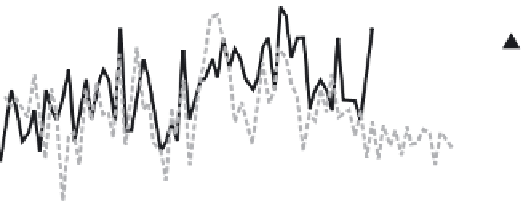Geoscience Reference
In-Depth Information
60
0.16
j
{T
A
40
Fire
Frequency
Charcoal
(in
2
20
0
0.0
-1000 -500 0 500 1000 1500 2000
BC
Year
AD
20
-2
Dry
PDSI
B
15
-1
Summer
PDSI
Fire
Frequency
10
0
5
Fire Frequency
0
1
Wet
0 400 800 1200 1600 2000
Year (AD)
f igu r e 27. (A) Fire frequency in the Sierra Nevada based on charcoal abundances from
sediment cores from i ve meadow or bog locations, compared with i re histories based on
i re scars from Giant Sequoias. Note that i re frequency was lower prior to 2,300 years ago
(300 BC) and particularly high during the Medieval period (AD 900-1600). Multidecadal-
to centennial-scale l uctuations in i re frequency are also exhibited in the record. (B) Fire
frequencies (solid line) and means of the Palmer Drought Severity Index (PDSI, dashed line)
showing the close correlation between the two. Fire frequencies, mean summer temperatures,
and PDSI all peaked at the end of the Medieval period and declined throughout the Little
Ice Age. (Figure redrawn from Swetnam et al. 2009.)
individual i res could not have spread from one grove to the next. Using a
chainsaw, they sampled cross sections inside the i re-scar cavities at the base of
dead trees. h e team dated the trees using ring-width patterns and recorded
the i re scars contained within annual rings. h eir analysis reveals that i res
were more frequent from A D 900 to 1400—coeva l with the Medieva l Climate
Anomaly, when an average of thirty-six i res burned every century. During the
centuries preceding the Medieval period and immediately following it, the
i re frequency was substantially lower, with an average of twenty-one i res per
century (see i gure 27A). h ese results are consistent with sedimentary char-
coal analyses from Sierra Nevada meadow cores, which also show a marked
increase in i re frequency during the Medieval drought (see i gure 27B).



































































